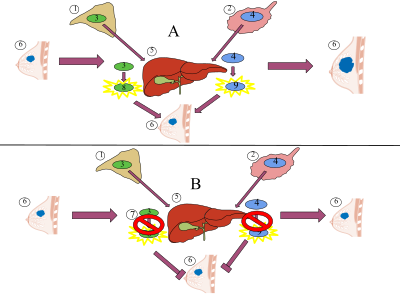Aromatase inhibitor
| Aromatase inhibitor | ||
|---|---|---|
Chemical class Steroidal; Nonsteroidal | | |
| Legal status | ||
| In Wikidata | ||
Aromatase inhibitors (AIs) are a class of
Medical uses
Cancer
In contrast to
Ongoing areas of clinical research include optimizing adjuvant hormonal therapy in postmenopausal women with breast cancer.
Gynecomastia
Aromatase inhibitors have been approved for the treatment of gynecomastia in children and adolescents.[6]
Ovulation induction
Ovarian stimulation with the aromatase inhibitor
Side effects
In women, side effects include an increased risk for developing
Mechanism of action

Aromatase inhibitors work by inhibiting the action of the enzyme
| Generation | Medication | Dosage | % inhibitiona | Classb | IC50c |
|---|---|---|---|---|---|
| First | Testolactone | 250 mg 4x/day p.o. | ? | Type I | ? |
| 100 mg 3x/week i.m. | ? | ||||
| Rogletimide | 200 mg 2x/day p.o. 400 mg 2x/day p.o. 800 mg 2x/day p.o. |
50.6% 63.5% 73.8% |
Type II | ? | |
| Aminoglutethimide | 250 mg mg 4x/day p.o. | 90.6% | Type II | 4,500 nM | |
| Second | Formestane | 125 mg 1x/day p.o. 125 mg 2x/day p.o. 250 mg 1x/day p.o. |
72.3% 70.0% 57.3% |
Type I | 30 nM |
| 250 mg 1x/2 weeks i.m. 500 mg 1x/2 weeks i.m. 500 mg 1x/1 week i.m. |
84.8% 91.9% 92.5% | ||||
| Fadrozole | 1 mg 1x/day p.o. 2 mg 2x/day p.o. |
82.4% 92.6% |
Type II | ? | |
| Third | Exemestane | 25 mg 1x/day p.o. | 97.9% | Type I | 15 nM |
| Anastrozole | 1 mg 1x/day p.o. 10 mg 1x/day p.o. |
96.7–97.3% 98.1% |
Type II | 10 nM | |
| Letrozole | 0.5 mg 1x/day p.o. 2.5 mg 1x/day p.o. |
98.4% 98.9%–>99.1% |
Type II | 2.5 nM | |
| Footnotes: a = In homogenates . Sources: See template.
| |||||
Types
There are two types of aromatase inhibitors approved to treat breast cancer:[14]
- Irreversible steroidal inhibitors, such as exemestane (Aromasin), forms a permanent and deactivating bond with the aromatase enzyme.
- Nonsteroidal inhibitors, such as the triazoles anastrozole (Arimidex) and letrozole (Femara), inhibit the synthesis of estrogen via reversible competition.
Members

Aromatase inhibitors (AIs) include:
Non-selective
- Aminoglutethimide (Elipten, Cytadren, Orimeten)
- Testolactone (Teslac)
Selective
- Anastrozole (Arimidex)
- Letrozole (Femara)
- Exemestane (Aromasin)
- Vorozole (R-76713; Rivizor)
- Formestane (Lentaron)
- Fadrozole (Afema)
Unknown
- 1,4,6-Androstatrien-3,17-dione(ATD)
- 4-Androstene-3,6,17-trione ("6-OXO")
In addition to pharmaceutical AIs, some natural elements have aromatase inhibiting effects, such as damiana leaves.
History
The development of aromatase inhibitors was first pioneered by the work of British pharmacologist
Investigations and research has been undertaken to study the use of aromatase inhibitors to stimulate ovulation, and also to suppress estrogen production.
Research
Research suggests the common
The extract from the herb
Natural aromatase inhibitors
| Species Name | Common Name | Family | Type |
|---|---|---|---|
| Aesculus glabra | Ohio buckeye | Hippocastanaceae | Plant |
| Agaricus bisporus | Baby button mushroom | Agaricaceae | Fungus |
| Allium sp. | White onions | Liliaceae | Plant |
| Alpinia purpurata | Red ginger | Zingerberaceae | Plant |
| Brassica oleracea | Cauliflower | Brassicaceae | Plant |
See also
References
- S2CID 211475185.
- ^ "Hormone Therapy for Breast Cancer in Men".
- S2CID 8350282.
- S2CID 8350282. [non-primary source needed]
- PMID 19139426.
- S2CID 39852740.
- PMID 26398071.
- PMID 27784593.
- S2CID 25842353.
- S2CID 195689537.
- PMID 23696617.
- ^ "Aromatase Inhibitors in Products Marketed as Dietary Supplements: Recall" (Press release). FDA. September 20, 2010. Retrieved August 9, 2012.
- S2CID 11210435.
- S2CID 2862849.
- ^ "Angela Hartley Brodie, PhD". University of Maryland Medical Centre. Archived from the original on 1 February 2016. Retrieved 22 January 2016.
- ^ Grohol, John M. (21 February 2009). "Robert A. Weinberg and Angela M. Hartley Brodie awarded 2006 Landon-AACR Prizes for Cancer Research". PsycheCentral. Archived from the original on 11 August 2017. Retrieved 23 January 2016.
- PMID 16647373.
- PMID 15001605.
- PMID 11739882.
- PMID 17178902.
- S2CID 41008940.
- S2CID 28593509.
- S2CID 22781113.
- PMID 18948180.
- PMID 24468305.
- PMID 18690828.
External links
 Media related to Aromatase inhibitors at Wikimedia Commons
Media related to Aromatase inhibitors at Wikimedia Commons
